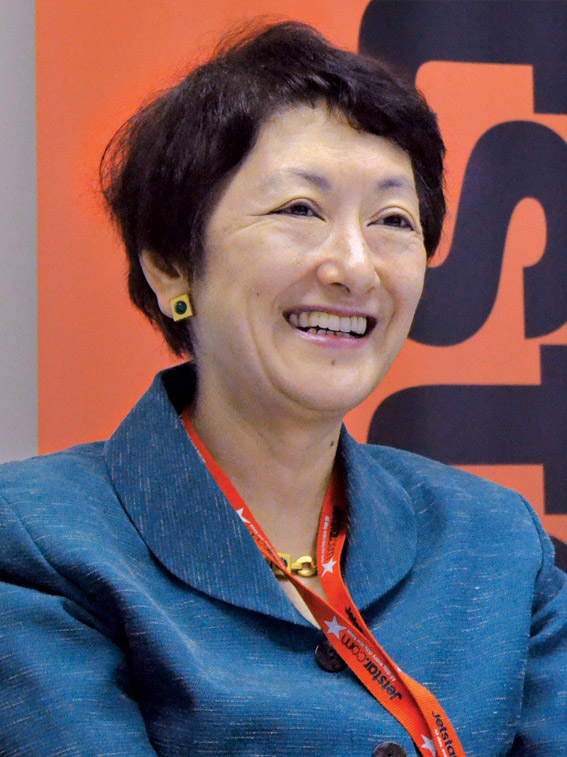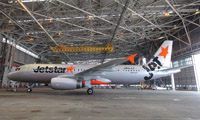Executive Interview
Suzuki on a mission
Jetstar Japan 'could have 100-plane fleet by 2020'
July 1st 2012
A game-changing chapter in Japanese aviation history jumps a few pages this month when Jetstar Japan, the second of three home-grown Japanese low-cost carriers (LCCs) to debut this year, makes its first commercial flight from Tokyo’s Narita to Sapporo, in western Japan on July 3. Read More »
Giving the launch of the new carrier an extra spin is the airline’s chief executive, Miyuki Suzuki, Japan’s first female airline boss, who has been preparing the airline’s market entry since her appointment last October.
 |
| Miyuki Suzuki Chief Executive Jetstar Japan |
Progress has been so successful that Suzuki made the decision to bring the launch forward by a few months.
Jetstar Japan, founded by Japan Airlines and Qantas Airways, along with Mitsubishi Corporation and Century Tokyo Leasing Co. as investors, plans to build up a domestic network from Narita, its main base, and later from Osaka’s Kansai International Airport.
Key changes will be the end of the dominance of the full service domestic carriers, All Nippon Airways (ANA) and Japan Airlines, together with the high fares that have characterized Japanese domestic aviation for so long.
Driving the changes are Jetstar Japan, and the other competing LCCs entering the arena this year, said the dynamic Suzuki. The 51-year-old chief executive came to Jetstar Japan with some 30 years of experience in the Asia-Pacific region in start-up industries, most notably in information technology, marketing and deregulation issues areas.
Entering the airline management business, which conventional wisdom has regarded as a male preserve, has not been an issue for Suzuki.
She is not the first female CEO in the Jetstar family. Jetstar Asia, based in Singapore, was led by Chong Phi Lain until February and she remains on the board. Jetstar Group CEO, Bruce Buchanan, was recently replaced by Jayne Hrdlicka.
Another industry example is Carolyn McCall, who has been chief of UK LCC pioneer, easyJet, since July, 2010.
 |
“I never really thought about it,” said Suzuki. “I don’t think [a woman in charge of an airline] is intrinsic. LCCs are new, fresh and something of a break with convention. That may have something to do with there being more women in LCC management.”
Lack of airline experience is not an issue either for Suzuki.
“When you’re running a company there are some basic management skill sets – such as how to run a business profitably to achieve growth. I spent a lot of time in the telecoms business, including five years running a B2B telecom company. Before that I headed the consumer division of Japan Telecom. I can tell you that there are certain similarities between the telecom business and the airline industry,” said Suzuki.
“First is the huge amount of capital expenditure up front.
“I was in the telecom business some 10 years ago when deregulation was happening. A huge change – a seismic shift – shook the industry. It was very similar to what is happening in the airline business in Japan now.”
Suddenly there’s a lot of freedom to compete – and incumbents don’t hold all the cards.
Although new domestic airlines have tried valiantly to offer lower fares since 1998, progress has been painfully slow. In 14 years the half dozen newcomers in Japan have succeeded in capturing only 9% of the domestic market.
Part of the reason has been what analysts call “the Japan Cost”, a barrier brought about by excessive regulation, sky high landing charges and airport fees, a unique and crippling fuel tax and high labour costs.
Despite these hurdles, the Japanese domestic air travel market is the third biggest in the world. It peaked at 96 million passengers in 2006, dropping to 81 million in 2010. Of the top 10 busiest city pair routes in the world, four are in Japan.
The LCCs will be setting fares at levels never before seen in Japan. Jetstar fares Narita-Sapporo start at 4,590 yen (US$58.30). This is about one tenth of the maximum one way fares of the legacy carriers.
The Jetstar Japan business model is leveraged on the basic Jetstar model established by Qantas in Australia, said Suzuki.
“Like Japan, Australia is an expensive country in which to run an airline. But the made-in-Australia Jetstar model works very well in other locations and we’re confident it will be successful in Japan,” she said.
“Fundamentally, the model does not rely on cheap labour, but reduces costs by being smarter. We use fewer people for tasks such as turn-arounds. We use multi-tasking by cabin crew, we use IT hand-held gadgets a lot for passenger boarding. We don’t need to lease gates.”
A possible handicap for Jetstar Japan raised by some analysts is access. The airline is presently denied the use of Haneda Airport, just 15 kilometres from central Tokyo. The carrier is at Narita, more than 70 kilometres northeast of the metropolis, and by that criterion less convenient.
“We don’t think that’s such a problem,” said Suzuki. “Haneda is an expensive airport and airlines operating there are more interested in high-yield business travellers, who by their very nature are busy and time-conscious.
“We believe Narita is better suited for leisure travellers, who want low fares and who have the time to use the more distant airport.”
Some analysts have said the Japanese are too fussy and finicky for LCCs to succeed. ‘The Japanese are used to – and expect - high levels of service’, is the conventional wisdom.
Not so, said Suzuki, in her fluent unaccented English. “Through research with focus groups we established that people thought safety, low-cost and on-time performance were most important in that order.”
But the Jetstar model has made some adjustment for the Japanese market with reservations. The airline places a lot of emphasis on internet booking, as is common among LCCs, but in Japan many customers still prefer the human touch.
With this in mind, Jetstar Japan has set up a call centre in Hokkaido with Bell Systems 24 and is cooperating with travel agents. Coming soon is a range of low-cost package tours made with travel giant, Japan Travel Bureau.
“We recognize that travel agents are very important in the Japanese market,” said Suzuki. Five years ago when Jetstar entered the international market in Japan, the company quickly found that ignoring travel agents and relying on the Web was not a good idea.
Suzuki believes that the future domestic air travel market for LCCs will evolve as roughly one third cannibalization, one third from completely new business – the ‘never flew before market’ - and one third from an increase in travel frequency by those who now fly once or twice a year.
By the end of the decade she predicted LCCs would have a 30% market share.
A characteristic of employment in Japan is the custom of big firms rotating staff to regional branches. Their families stay behind. “Low fares will bring such divided families together much more frequently and much more cheaply,” said Suzuki.
She emphasized the role LCCs can play in expanding demand. She said in the Sydney-Melbourne market in 2009-2010, LCCs helped create a situation where the average fare on the route fell 50%, but the total market grew by four-fold. “That could happen in Japan,” she said.
Japanese women are also a marketing target, especially those in their 20s and 30s. Jetstar surveys have shown that Japanese women are often behind the family’s travel decisions, said Suzuki.
Unlike the two other LCC competitors entering the market this year, Peach Aviation and AirAsia Japan, Jetstar Japan has not announced specific international route launch plans. However, Suzuki intends to start short to medium-haul overseas flights early in 2013.
Suzuki is very bullish on expansion. The carrier’s present fleet plan simply states it hopes to have 24 A320s in service ‘after a few years’. But Suzuki believes that by 2020 they could have as many as 100 aircraft in service.
“Why not, if growth develops, boosted by ultra-low fares?” she said. Future fleet needs might be for larger, longer range airplanes, such as A330s or similar capacity aircraft.
Meanwhile there was a definite buzz in the Jetstar Japan open plan head office. The sense of a build-up was palpable. Suzuki moved about the floor, greeting staff and exchanging conversation. A woman’s touch seemed to be at work, inspiring the Jetstar Japan team.